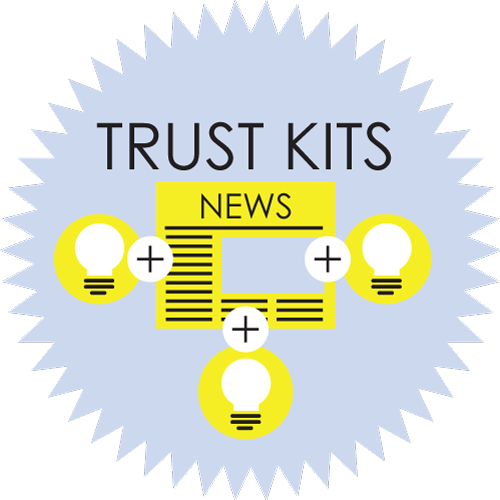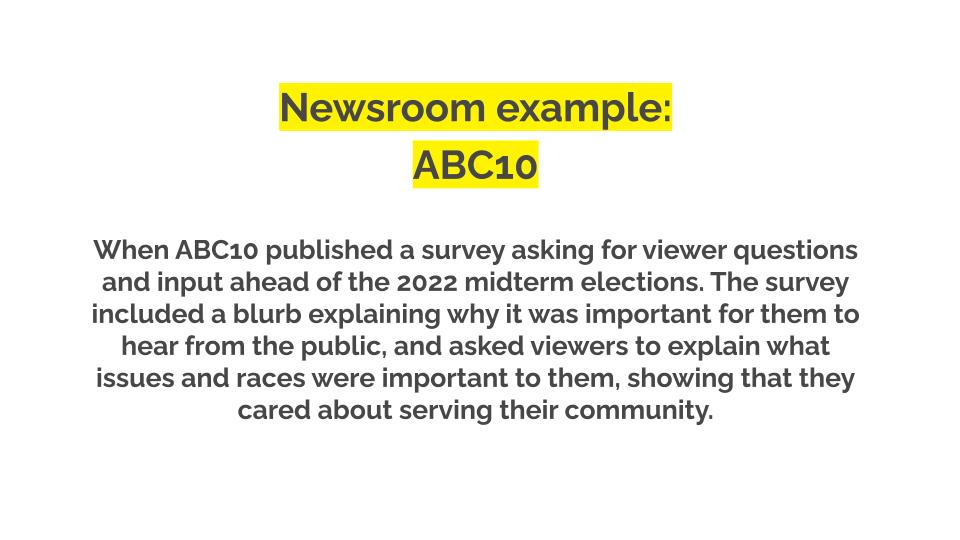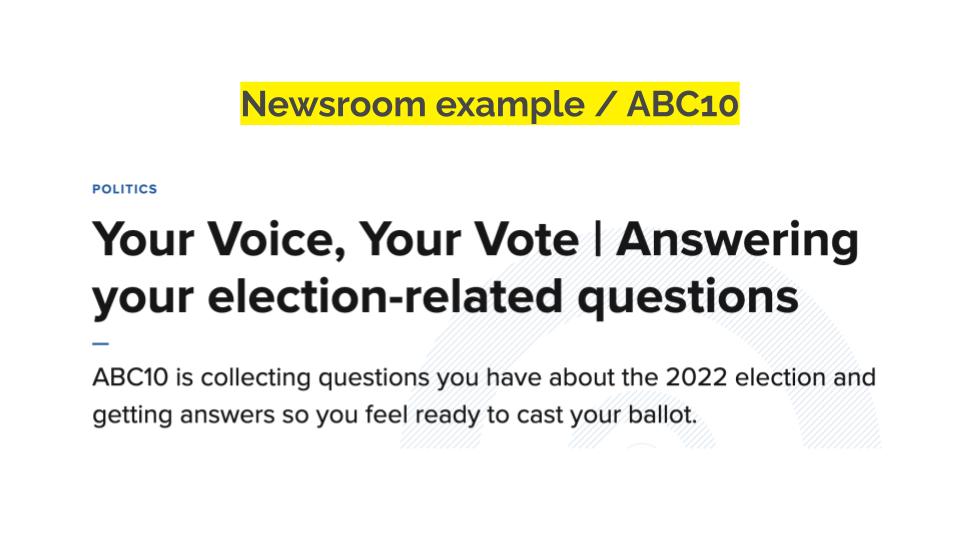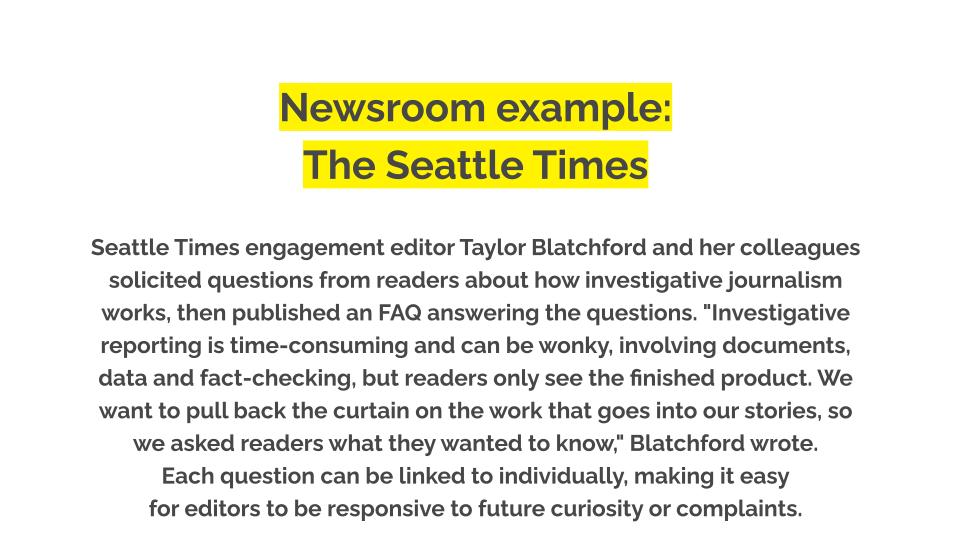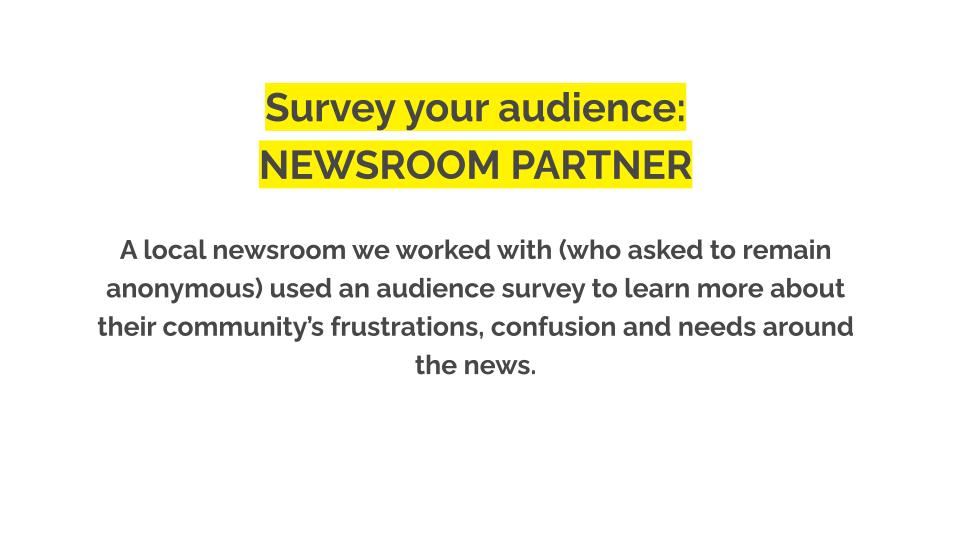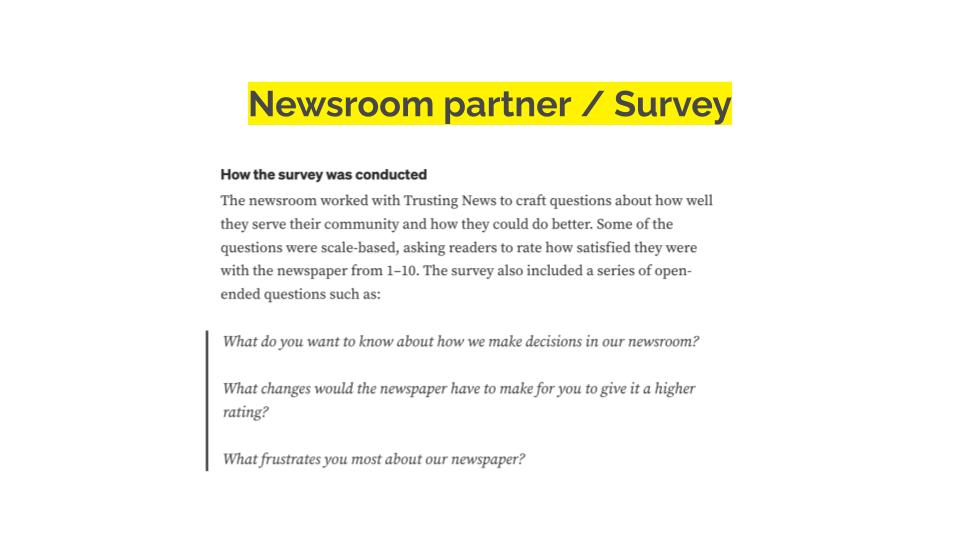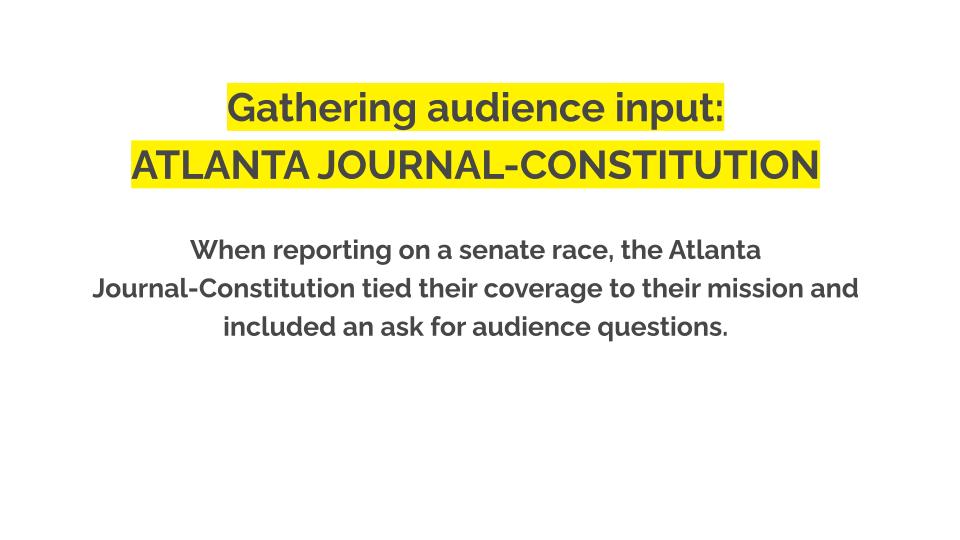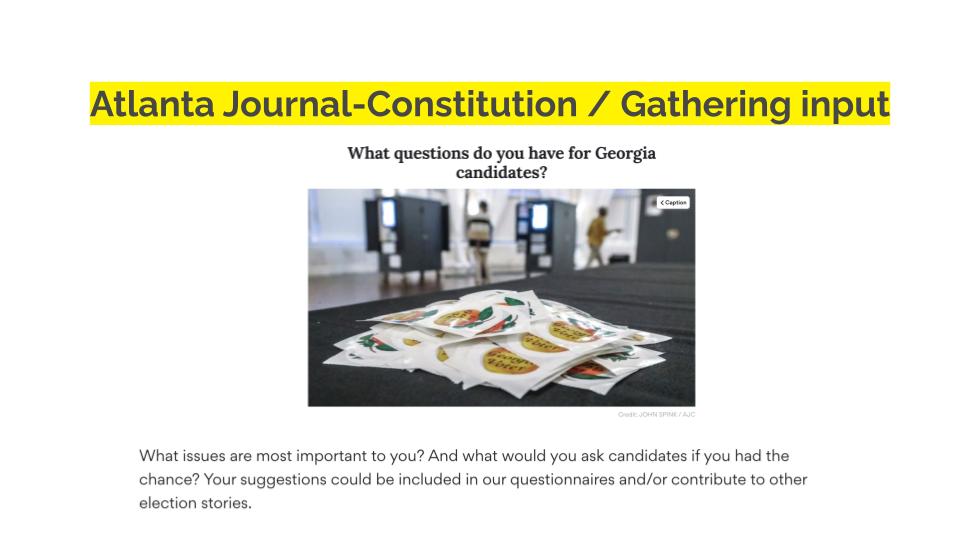ENGAGEMENT
Seek audience input (and act on it)
You may feel as if you’re hearing plenty of feedback from your community. If you look at inboxes and comment sections, you probably see tons of snarky remarks being thrown your way these days. But a lot of that isn’t particularly thoughtful, right?
Instead of focusing on those comments (we have another Trust Kit for that) we’d rather talk about good faith reflections on how well your local news is serving your community. Are you getting enough of that kind of feedback? Are you really understanding whether your community finds your work useful, and if they think you’re covering them in a thoughtful, accurate, inclusive way?
If journalists want to provide the best possible public service to communities, we have to start regularly asking for our audience’s input (in an authentic, meaningful way). Then we have to use what we hear to shape our coverage.
This Trust Kit will help walk you through how you can do just that.
Do you really understand whether your community finds your work useful? Do they think you’re covering them in a thoughtful, accurate, way?

Goals
This Trust Kit helps you:
- Ask for community input in productive ways
- Identify and refine knowledge around local community members’ perceptions of local news
- Communicate more regularly with people who have low trust in news and address their frustrations
- Act on feedback to improve your overall coverage
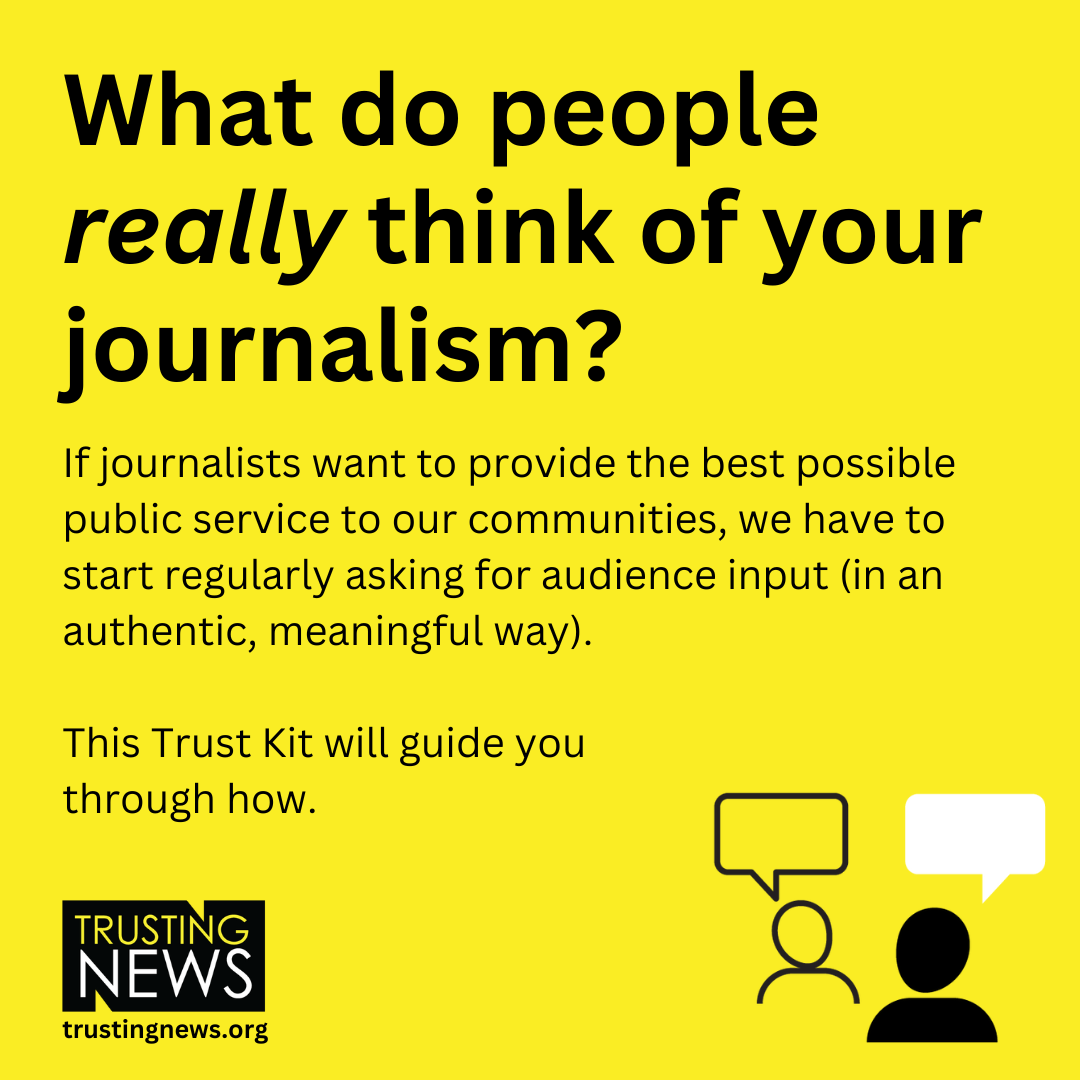

How to ask for audience feedback
It has become a common practice in many newsrooms to regularly invite the audience to suggest ideas and help shape coverage. That is great to see! But the way journalists invite input can at times feel generic and self-serving.
Our goals are to build relationships and connections, and to learn what our communities need from us, right? But too often, we wrap those goals in our own language (not our community’s language) and make it seem like a lot of work to participate in.
Take asking for story ideas. That’s a great concept — we just want to make sure we’re doing stories people are interested in, right? But when you ask for story ideas, the question is framed around solving *your* problem, not your community’s. (Who in your community is walking around looking for story ideas?) So how about getting more specific with your invitation? Invite them to connect your need to their lives — to see themselves in your work.
Same goes for asking for “feedback.” Feedback is one of those terms that is so general it can be paralyzing. The more complex a situation or relationship, the more difficult it is to come up with specific feedback. Will people know what to even give you feedback about?
Try asking some of the questions below instead. Questions like these can go anywhere you’re communicating with your audience — on air, in a social post, in a newsletter, in italics at the top or bottom of a story, in a box next to a story, etc. Click or tap the blue boxes to expand each section.
Question: What kind of coverage do people want?
- What are journalists missing in our community? We want to hear from you.
- If you could be in charge of our reporting team for a day, what would you assign them to do?
- What do you wish the community knew more about?
- What people or programs are working hard for our community and deserve more attention?
- What problems do you wish our community were addressing?
- What else do you want to know about this topic? Let us know what questions you’d still like answered.
Question: How can coverage be more reflective and inclusive?
- What do you wish journalists understood about how you see the world?
- What does news coverage often get wrong about things you see in your life?
- We try hard to cover life in our community from diverse angles, but we know there’s some we may miss. What would you like us to do better at capturing?
- This is a complicated issue, and our goal is to reflect voices from a diverse set of stakeholders. Whose voice(s) have we missed?
- In this story, we worked hard to share diverse perspectives and highlight them fairly. How did we do?
Question: What do people think of my journalim?
- We took time today to explain how we make decisions. Did you find it interesting and worthwhile? What else would you like to know about our reporting process?
- We can’t cover everything, and our goal is to assign reporters to cover issues and events that matter to the community. How are we doing? What are we missing?
- Have you ever talked to a journalist for a story? What was the experience like?
- How could we better earn your trust? Sample language: We know this is a tough time to keep up with the news, and we want to be your most trusted source for information about our community. A shared set of facts and a place to talk about them are core to democracy. We’d love to hear from you: How could we better be worthy of your trust? What questions can we answer about how our newsroom operates?

More strategies
Here are some additional strategies to start engaging with your audience to get meaningful input and guidance from them. Click or tap the blue boxes to expand each section.
Host a community survey
Creating a survey can be a great way to engage with your audience and get in touch with your community’s frustrations, confusion and needs.
Here’s an in-depth look at how we worked with one local newsroom on a community survey.
Some advice as you craft questions:
- Ask some quantitative questions you can repeat over time for benchmarking (How likely would you be to recommend this news outlet to a friend? To what extent do you find that this outlet provides accurate, credible information?)
- Ask questions that will help you make decisions and steer future coverage (If you could assign a reporter to any issue or topic, what would it be? What do you most rely on our newsroom/our journalists for?)
If your goal is to find out how well you are serving your existing audience, you can use existing channels to send out a survey. Consider newsletter lists, subscriber lists, social media channels, texting sign-ups and anywhere else you regularly reach your current audience.
If, however, you want to find out from your wider community what they need from local news, consider options such as paid outreach and partnerships with community organizations to spread the invitation more widely.
We also highly recommend checking out Membership Guide’s audience handbook. It includes a section on surveys that walks journalists through how to design, structure, promote and test a survey.
Once you’ve finished your survey, look at the responses honestly. Moving forward, use that list of questions to anticipate ways you would better explain your process and decisions to your audience.
Head to the bottom of this Trust Kit to see our best practices around acting on audience input.
Do one-on-one listening
If you’re really committed to listening and learning, start with our community interview guide. Perhaps have each journalist in your newsroom commit to interviewing one person a month who has low trust in news. One question we especially love to ask: What do journalists often get wrong about you or about things in your life?
It can seem tedious or like a lot of work (you’re spending 30-60 minutes talking to someone who isn’t necessarily a source!) but we’ve seen the positive impact interviews like this can have. Our research partners said they found these one-on-one conversations help build trust, make people more likely to subscribe, and give journalists a deeper understanding of what they need to do to earn trust.
Learn more listening strategies in the Listening Trust Kit.
Point to your mission and goals
Like with all transparency and engagement efforts, they work best if you tie them to your organization’s overall mission and goals. That helps people understand why you might be asking them for guidance and demonstrates that hearing from your community aligns with your goals.
You can do this by pairing questions with language about why you’re asking. Some examples include:
- It’s important to us that our work be based on the community’s needs and curiosities. Are you willing to help shape our priorities?
- Part of our mission as a news organization is to uplift and reflect the community. What sort of things do you wish you saw more of in our news coverage?
- Our newsroom of XX people can’t be everywhere, and we rely on you to help keep us in the loop about what’s happening.
- Our journalists know what *we’re* curious about on this topic, but we want to make sure we answer *your* questions, too. What would you like to see us find out about this issue?

Act on what you hear
It’s great to ask for input and gather ideas from community members. But you know what’s not great? Asking, and then doing nothing. (From a trust perspective, that’s worse than not asking at all!) Avoid this mistake by making a plan on how you’ll act upon the input you hear from your community.
Here are ideas for how to do that.
- Put someone in charge. Assign someone to keep an eye on the submissions and look for patterns. Then set up a way for them to regularly report what they are hearing back to the newsroom.
- Look for themes. Have journalists share a summary of what information they gather back with the team. You could use a Google form for easy tagging and sorting of answers. To easily share insights, they could share one key thing they heard in a dedicated Slack channel or other newsroom-wide communication systems. You could also ask one person to elaborate on their encounter in staff meetings.
- Track what you change. Identify how you’re changing your coverage as a result of what you hear. How are the reporters changing their story selection? Story framing? Sourcing? Word choices? Have assignment editors ask reporters to identify the changes. Talk about those in story meetings and newsroom discussions.
- Get an outside perspective. Don’t rely on your internal perspectives to decide if the changes are effective. Ask particularly insightful or passionate participants to keep in touch. When you produce a story you hope might address their concerns, ask them to look at it. If they spend significant time with the content and providing feedback, be sure to respect that time. Feed them or compensate them.
- Share back with your audience. It’s important to follow up and close the feedback loop. Be sure to thank anyone if they offer you feedback or ideas, and follow up if you make any changes based on their recommendations. If you don’t, still follow up by letting them know they’ve been heard. And when you publish a new story series or implement an idea shaped by what you heard from your audience, be sure to note that in the content itself.
See how other newsrooms do it
For inspiration, here are some examples of how newsrooms have sought out input from their audiences. For more newsroom examples, check our our newsroom example database.
We’re here to help!
Congratulations on getting this far in the Trust Kit! 🎉 We know taking the steps to earn trust isn’t always simple or easy. It takes time and often requires a shift in newsroom routines or workflows.
Any progress you make on implementing strategies in this Trust Kit should be celebrated as a win!
If you find yourself getting stuck, need help brainstorming, or have completed the work in a Trust Kit and would like our team to review and give additional advice, reach out to us at info@trustingnews.org or send us a message on Twitter.
This Trust Kit was last updated May 31, 2023.
